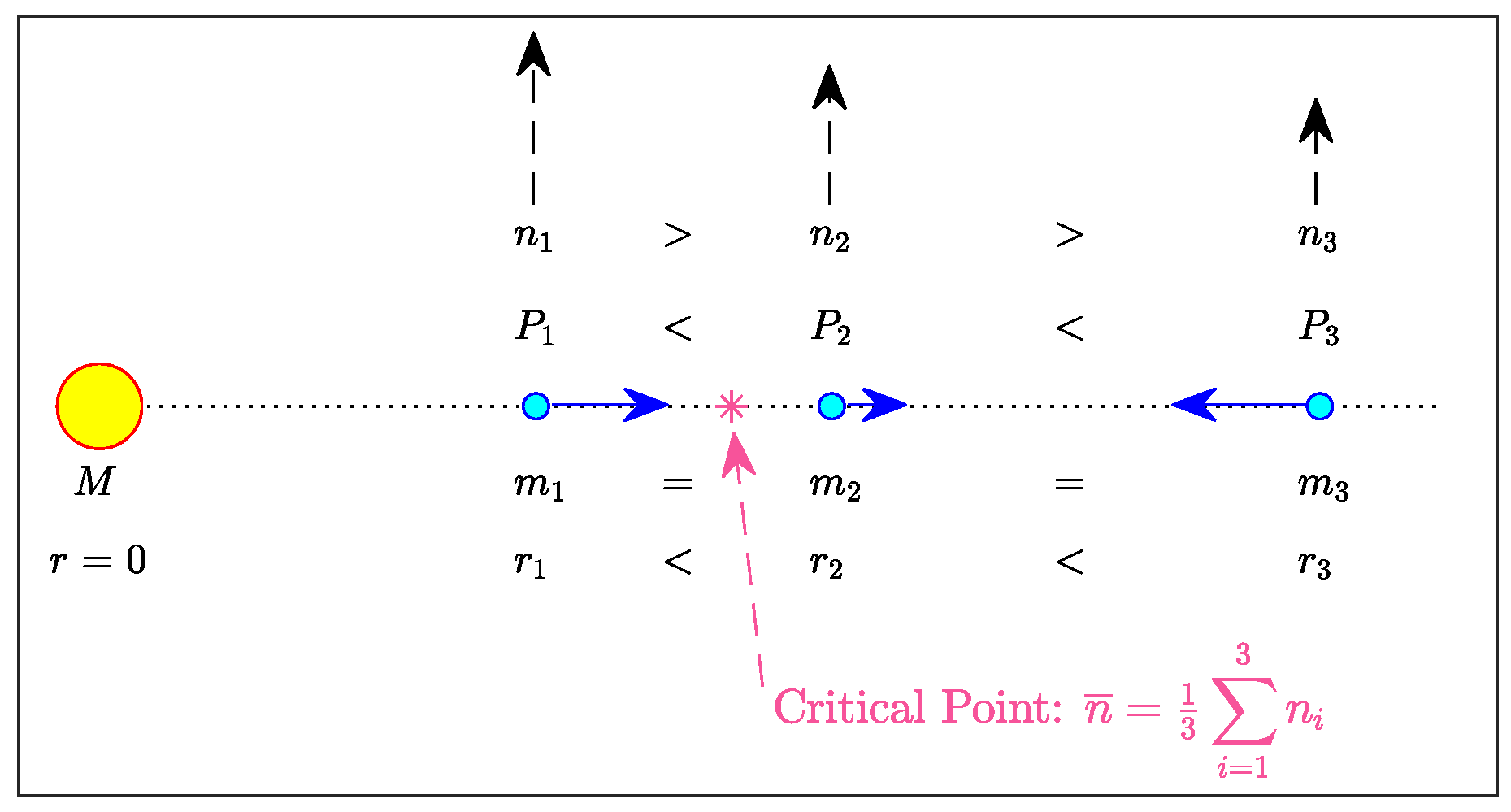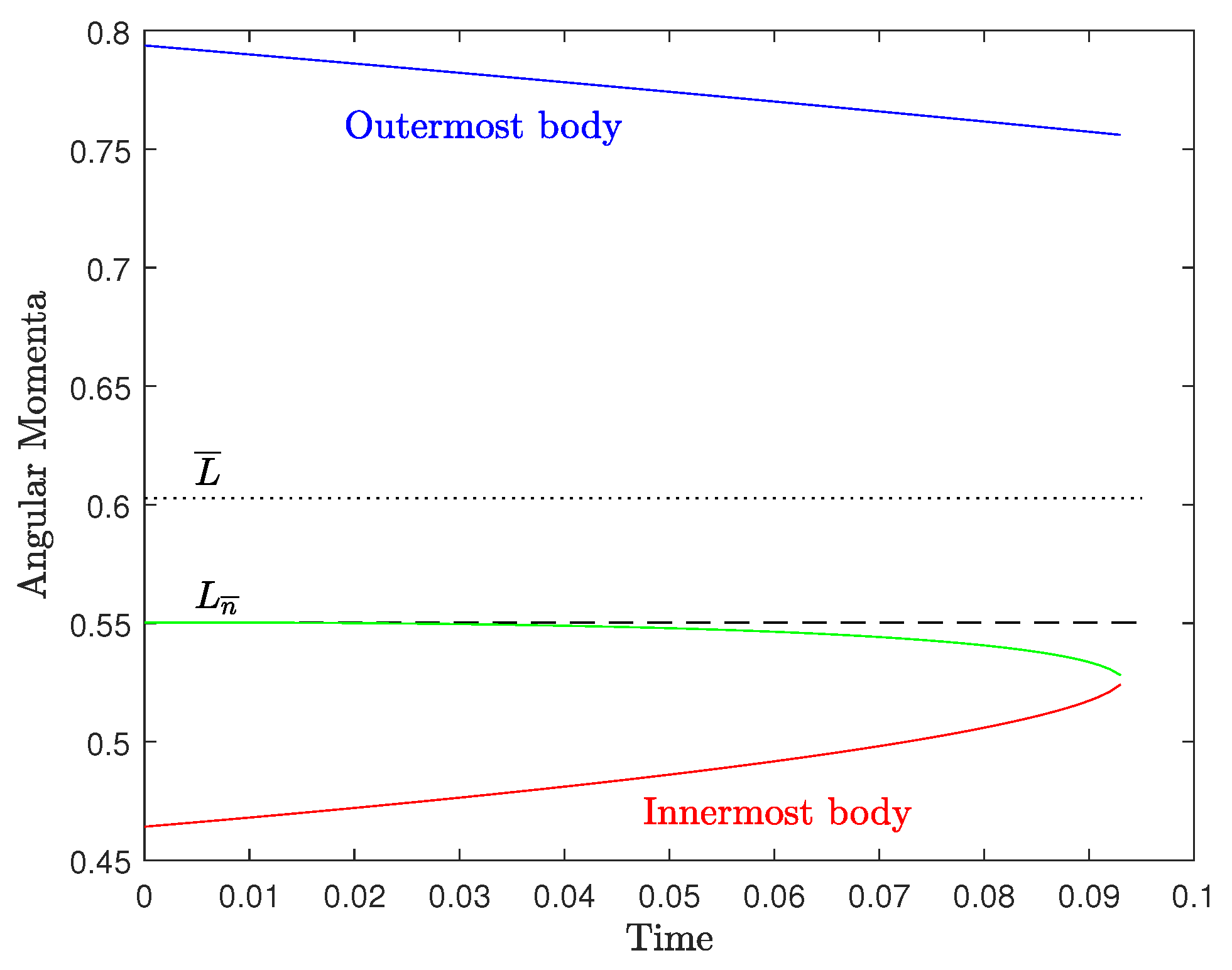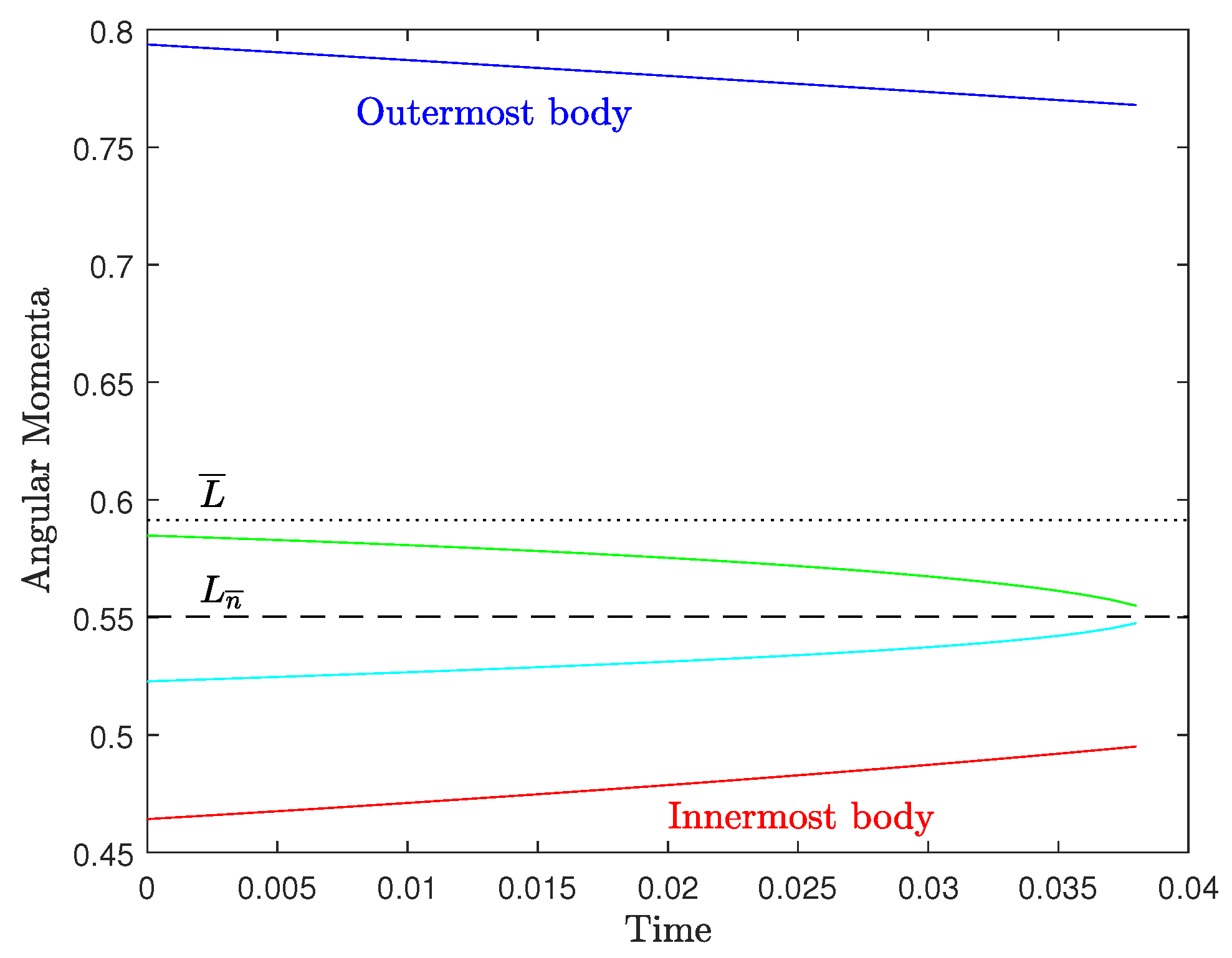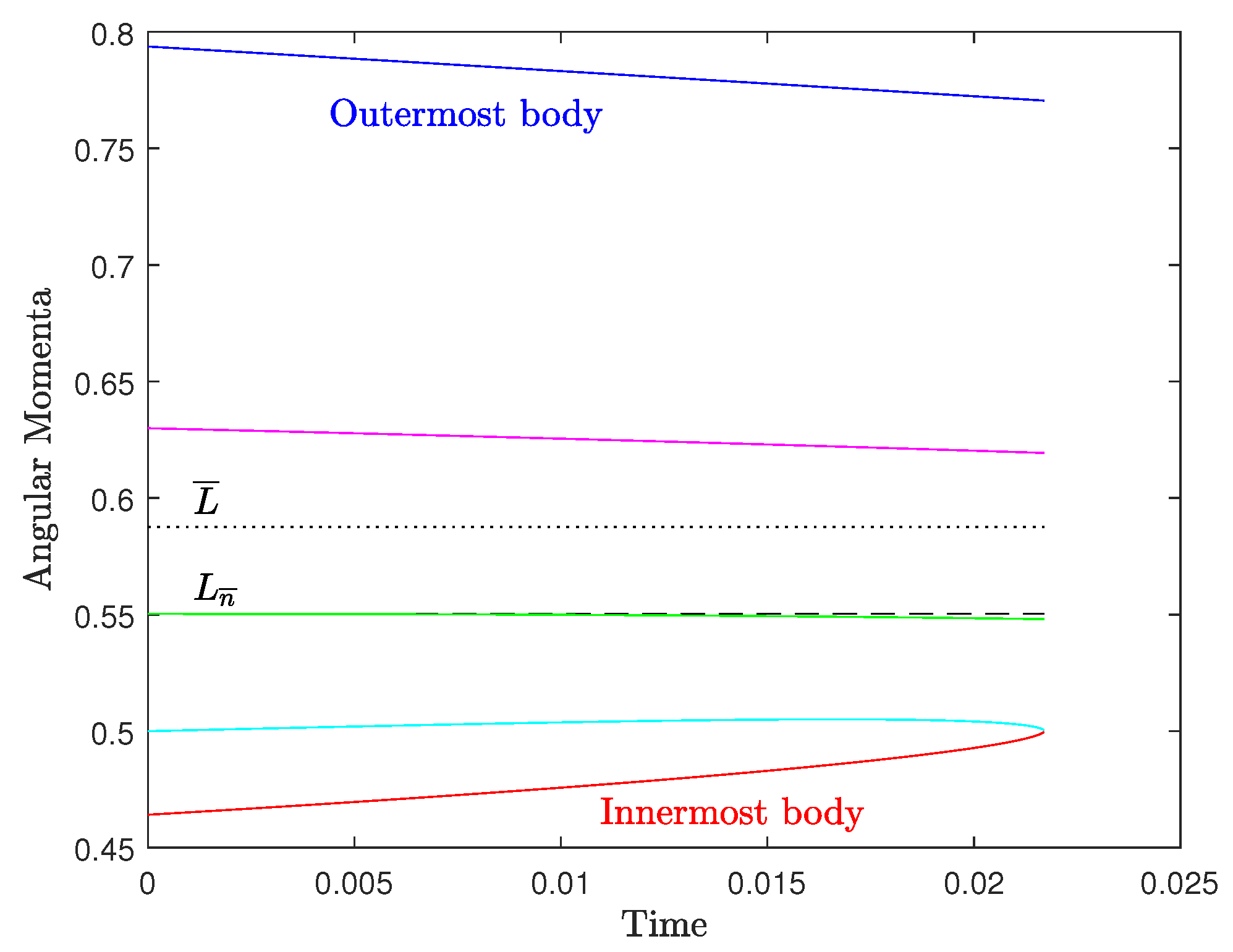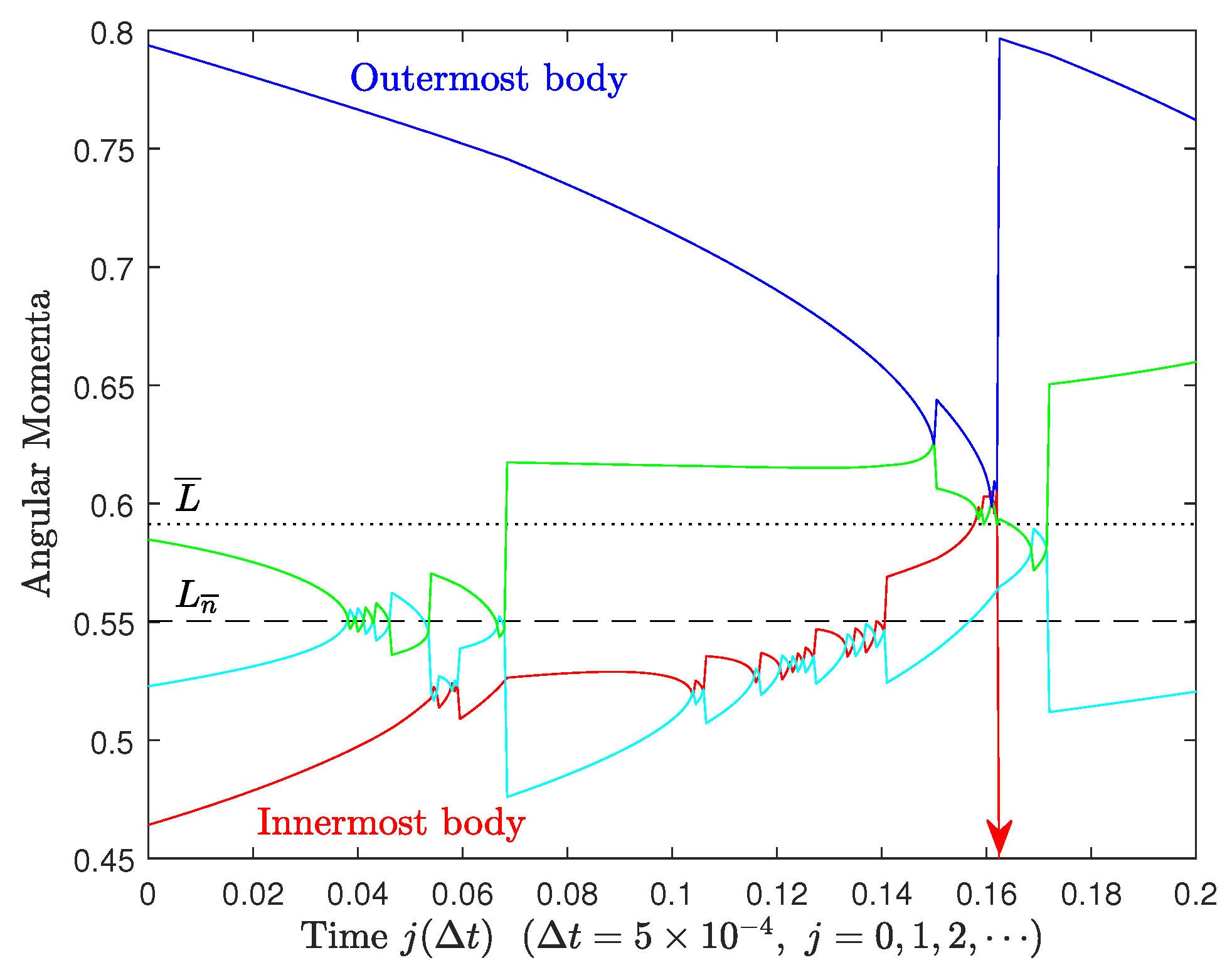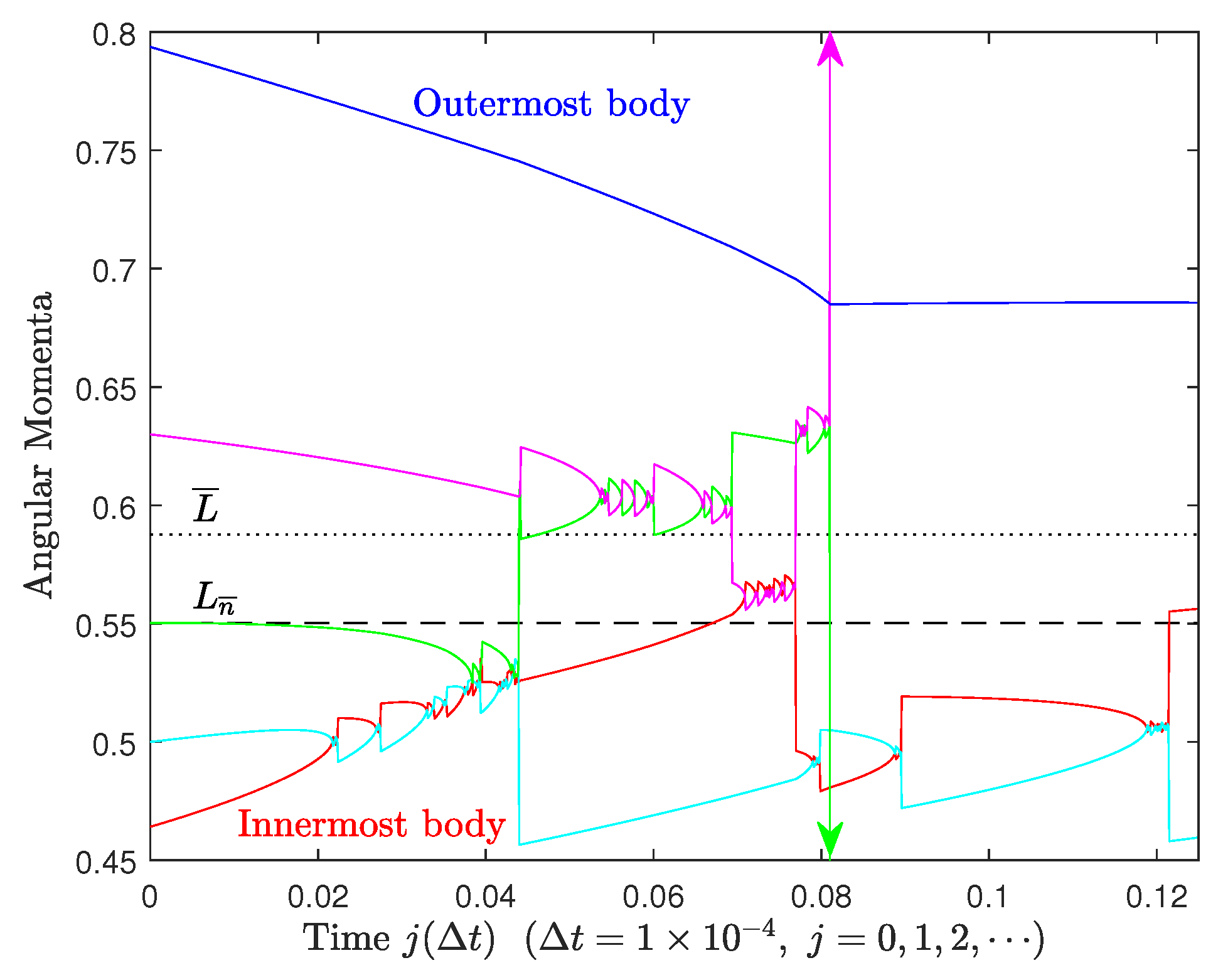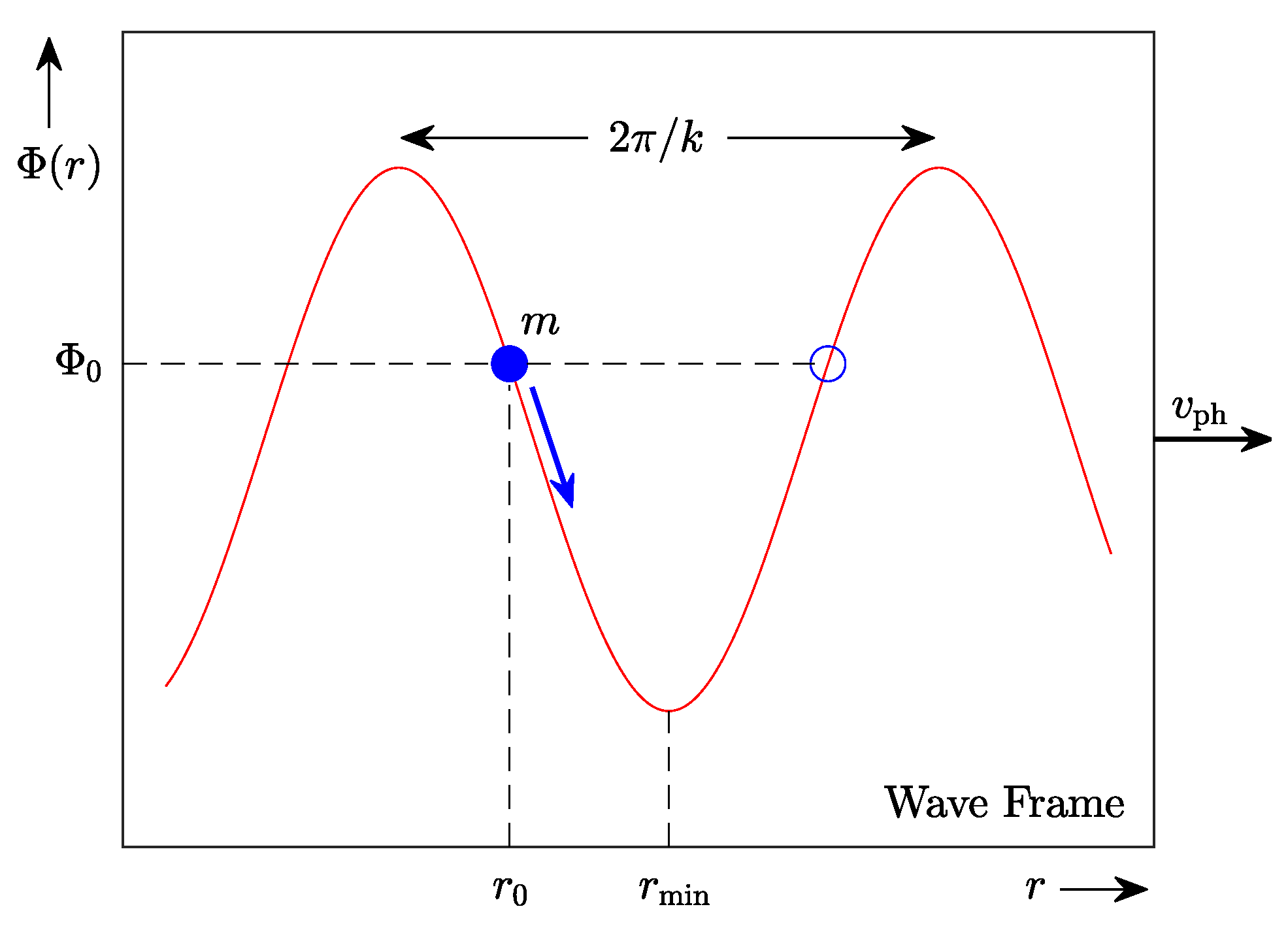Goldreich [
25] studied local mean-motion resonances (MMRs) between pairs of satellites and found that the resonant configurations are not disturbed by tidal forces. This treatment confirmed that the tidal field created by the massive bodies in each (sub)system seems to be absent when the bodies all settle near MMRs. But these local paired calculations did not provide a reason for the absence of the field. Nor could they, because MMRs are a global phenomenon that takes place over the entire (sub)system. Goldreich [
25] could not imagine that the underlying field is nowadays severely curtailed or dispersed altogether, so he hypothesized that the resonant body pairs may regulate the transfer of angular momentum in ways that maintain their resonant configurations. Of course, this cannot be the case; the results in
Appendix A show that each body, resonant or not, receives and distributes angular momentum based on the conservation of the total amount and the small dissipation rate. So no body is capable of regulating transfer globally, although the most massive body will be perturbed much less, solely on the basis of its larger inertia.
Appendix C.1. Damping Mechanism
A complete satisfactory physical interpretation of LD was lacking until recently, although the outcome is no longer disputed. In plasmas, LD has been verified experimentally [
11,
20] and by simulations [
34]; it is also used to stabilize electron beams in accelerators ([
29] and references therein). Recently, following the tradition of Dawson [
18], the seminal works of Ryutov [
59] and Wesson [
68] gave clear descriptions of LD using only real variables, and their derivations make the physics behind the damping mechanism of the mean field much better understood. On the other hand, some detailed descriptions using complex variables are found in influential books on plasma physics [
5,
8,
22,
62]; although such convoluted mathematical treatments may obscure the physics behind the effect.
The damping mechanism in plasmas and stellar systems opearates as follows. Resonant particles gain energy from the mean field and become nonresonant, i.e., they move at speeds substantially higher than the phase velocity of the mean wave. Then, other slower-moving particles become resonant and they also gain energy from the field. The process continues until the field is robbed of its energy and dissipates away. This mechanism cannot work in exactly the same fashion in few-body systems because of the small number of ‘particles’ involved. Instead, the mean field is weakened every time a massive body becomes resonant (i.e., it ‘levitates’ at the top of a wave crest), and the mean tidal field disappears altogether when the few major bodies all end up near resonances, where they no longer support collective tidal interactions.
In what follows, we adopt the treatments of the linear LD by Trigger et al. [
63] and Fitzpatrick [
22], two resources providing clear physical insights, and we customize their analyses to the few-body gravitating systems of interest. We provide four theoretical derivations related to GLD that are illuminating despite the mild use of complex variables; they complement nicely the real-value calculations recommended above [
18,
59,
68]. First, we derive the characteristic screening length (analogous to the plasma Debye length [
5,
8]) for few-body systems (§
C.2). Second, we verify that this screening length is formally applicable to planetary (sub)systems, and we quantify the GLD rate [
63] for Jeans-stable waves (§
C.3). Third, we show a crucial elementary proof [
22,
62], that bodies near the phase speed of such a wave will interact strongly with the wave; thus, they are the ones participating in substantial energy exchanges and causing linear LD (§
C.4). Fourth, we describe the longitudinal oscillations of a single body, initially in phase with the tidal wave, and trapped in a potential trough of the decaying tidal field (§
C.5). Finally, we close with an application of the results to two important four-body subsystems in our solar system, the gaseous giant planets and the Galilean moons of Jupiter (§
C.6).
Appendix C.2. Jeans Wavenumber and Hill Radius
GLD operates at short wavelenths
, where
k is the wavenumber. The question is how short. With an eye on GLD in stellar systems, Binney and Tremaine [
7] determined the condition that
for standing waves to be necessarily damped (there are no travelling waves in the system),
8 where
is the critical Jeans wavenumber defined by the equation
where
is the gravitational (Jeans) frequency and
is the velocity dispersion of stars.
For the few-body systems of interest, there is no predetermined Jeans wavelength, although we know empirically that the systems are dynamically stable, so they are not in any danger of suffering the dynamical Jeans instability. We need however to determine a threshold akin to
. We proceed as follows: In plasma physics, the Debye length is used to determine the volume inside which the field of one electron dominates relative to the mean field produced by all electrons. In our case, an analogous screening length is the Hill radius
h [
61], viz.
where
r is the orbital radius,
M is the central mass, and
m is the mass of an orbiting body. Although not a systemic constant,
h is a fair description of the sphere of gravitational influence around individual orbiting bodies.
It turns out that the above two scales are reciprocal. To show this, we need to redefine our concepts of Jeans frequency and velocity dispersion for few bodies with
in Keplerian orbits about central mass
M. We adopt the usual Keplerian orbital parameters, i.e.,
and
, where
G is the gravitational constant. The Keplerian orbital frequency is naturally the
de facto gravitational frequency in this case, i.e.,
We also use the radial derivative of the
given above, i.e.,
,
, and
. Then, combining these equations, we find that
and then equation (
A35) gives
Another important relation is obtained when we transform the Jeans frequency that dictates the zeroth-order tidal field to a corresponding Hill frequency
localized to individual bodies. Combining equations (
A36) and (
A37), we find that
As will be seen below, the factor of 3 in this relation is significant. For later reference,
AU and
yr for Jupiter in our planetary system now; and
Mm and
d for Ganymede in Jupiter’s satellite subsystem now.
Appendix C.3. Regimes of Jeans Instability and Gravitational Landau Damping
The above relations describe fundamental parameters that appear in the dispersion relation and the Landau damping rate for few-body systems. The same parameters have also been derived for a stellar system by Trigger et al. [
63] (hereafter TEvS) in a fundamental piece of work that has been flying under the radar of the astronomical community for 20 years. In particular:
- (a)
TEvS considered an ‘infinite’ self-gravitating collection of masses with uniform density
, in which case the Hill frequency
is a constant defined by the equation
- (b)
This idealized system contains two species of particles with masses
m and
. To rewrite
as a ‘global’ quantity, we imagine a spherical volume of radius
r containing a mass
M (smaller masses
are neglected) with mean density
, in which case we obtain
or
, which is the same as equation (
A40) for few-body systems. Now it becomes evident why we used here the symbol
for the frequency
(TEvS call it
), just as we did in §
C.2 above. The need for radius
r to be taken around a mass
M stems from the peculiarities of this infinite uniform self-gravitating model (any mass
M can be a central mass in its vicinity, where the geometry then becomes spherically symmetric).
- (c)
-
The linear stability analysis of this Jeans-like model also establishes the local ‘Debye length’
D, viz.
which TEvS call the Debye-Jeans radius, although they point out that this
D is not related to screening (a minor oversight that neglects the role of the Hill radius in gravitating bodies). Here
is the thermal velocity of fast particles belonging to the
m-species in 3 dimensions. In one dimension, the velocity dispersion
will then be
and then we find that
Thus, the precise correspondence between parameters in the two models (§
C.2 and §
C.3) is formally established.
- (d)
Collisions between heavy and light particles must be included in the TEvS model, otherwise the number of particles is not conserved. On the other hand, few-body systems are collisionless in the long run (some ejections of lower-mass bodies by the massive bodies are expected in early evolution); thus, for our application, we reduce the equations of TEvS to the limit of zero collision frequency ().
- (e)
-
The TEvS dispersion relation in the limit of
(their Equation (
15)) reads
where
k is the wavenumber and
of a radial mode with frequency
. The function
is given by
where, in our case,
, with the asymptotic behavior
In equation (
A48), the denominator
is generally not singular owing to the presence of the collisional term
(equation (
A47)). We distinguish two physical regimes in the dispersion relation (
A46):
1.
Classical Jeans Instability Regime.—For
, when collisions are retained (that is, for
in equation (
A47)), equation (
A48) can be integrated along the real axis. The dispersion relation takes the
f-dependent form of Equation (
19) in TEvS. In the limit of
, this form reduces to the dispersion relation
Evidently, the two-species model exhibits the classical Jeans instability for long-wavelength modes (
), provided that the characteristic ‘sound speed’
is defined as
In comparison to the few-body system of §
C.2 with parameter set
, the two-species Jeans model then shows the following parametric relations:
2.
Gravitational Landau Damping Regime.—For
and for short wavelengths
, equations (
A46), (
A47) and (
A49) combine to give
in the limit of
. These are the Landau-like modes and they are all damping since
for
. For wave amplitudes
, the damping rate (
) is
For the few-body systems of interest,
and the damping rate
takes the form
Thus, in this model, the damping rate is proportional to the local Hill frequency
(equation (
A40)); whereas in the TEvS two-species infinite model,
is proportional to the constant frequency
(equation (
A41)). In both models, waves with very short wavelengths (
or
) are damped at much higher rates (
). On the other hand, waves with
and wavelengths stable to Jeans modes of size
tend to persist for the longest times. In §
C.6, we describe an application of this result to the gaseous giant planets in our solar system and the Galilean satellites of Jupiter.
Appendix C.4. Bodies Interacting with their Collective Tidal Field
A one-dimensional radial tidal field
generated by a few massive gravitating bodies is described by the equation
where
is the amplitude (dimension of [acceleration]),
k is the radial wavenumber, and
is the frequency of the wave. Any of the major bodies in this field feels an acceleration
due to the collective influence of the other massive bodies of the same form, viz.
In the absence of the field, a body initially at
with initial radial velocity
will move to
, and we can introduce the initial conditions to the perturbation by substituting the zeroth-order solution into the exponential term of equation (
A58) [
22,
62], viz.
Integrating in time, we find for the radial velocity
that
For initial radial velocities
of bodies that are close to the wave’s phase velocity
we resolve the indeterminate form in the last bracket of equation (
A60) by de L’Hospital’s rule, and we find that
Thus, bodies with velocities close to
(resonant bodies) will be subjected to linear velocity perturbations that grow in time. They will lose energy to the wave or gain energy from the wave, and they are responsible for the overall damping of the wave when it occurs eventually. This explains why in all related calculations, the damping rate
depends on the negative slope of the distribution function
evaluated at
(e.g., [
68]). But it does not explain why wave damping predominates wave growth, as the perturbed bodies may gain or lose energy in their interactions with the wave depending on their phases.
More detailed considerations are needed in order to understand the damping of the mean field. Following the clear descriptions given by [
22] and [
68], we make the following important points for plasma fields, and then for tidal fields:
- (a)
It is certainly not the case that slightly faster-moving bodies will lose energy and slightly slower-moving bodies will gain energy from the wave, as is commonly quoted. This misconception invalidates the analogy with the famous example of a surfer riding an ocean wave. Whether a resonant body will gain or lose energy depends on the phase of the wave upon energy exchange. In other words, a radially oscillating body trapped within its Hill radius with radial veclocity near the wave’s phase velocity will rob the wave of some of its energy only if its oscillation is in phase with the wave (see §
C.5 below).
- (b)
The ‘density’ perturbation generated by a displaced body is not in phase with the wave [
68], so the initial wave cannot generate an initial distribution in which energy gain or loss by bodies is favored [
22].
- (c)
Considering only resonant bodies starting with velocities , if they gain energy, they will move away from resonance; whereas if they lose energy, they will move closer to the resonant velocity . The end result is that the latter bodies interact more efficiently with the wave and, on average, the field gains energy from bodies with . The opposite holds for bodies with for which the gainers are more efficient and the field is damped.
- (d)
In a Maxwellian radial velocity distribution (even a sparse one with just 4-7 bodies), or in any other distribution with a roughly similar (bell-shaped) profile, there will be more bodies with
; thus on average, the wave will have to push on most of them and it will be damped. It is for this reason that the
negative gradient of the distribution function at
determines the damping rate [
68].
We note that items (c) and (d) above are not as dominant in few-body systems because few bodies have another mechanism available to them (settling into MMRs) in order to stop contributing to the mean tidal field, thereby undermining it to a large extent. We describe GLD occurring in just a few gravitating bodies in §
C.5 and §
C.6 below.
Figure A7.
Schematic diagram of a body of mass
m trapped in a trough of the potential
due to the standing tidal wave
described in §
C.4 above. The body starts at
with relative velocity
in the wave frame. As it is settling toward
(exact resonance), it bounces back and forth radially between turning points of opposite phases, such as the points indicated by blue circles.
Figure A7.
Schematic diagram of a body of mass
m trapped in a trough of the potential
due to the standing tidal wave
described in §
C.4 above. The body starts at
with relative velocity
in the wave frame. As it is settling toward
(exact resonance), it bounces back and forth radially between turning points of opposite phases, such as the points indicated by blue circles.
Appendix C.5. A Resonant Body Trapped in the Tidal Potential
Consider a resonant body, initially at
, trapped in a trough of the mean tidal potential
of a standing tidal wave, in a reference frame that moves with the phase velocity
of the wave (e.g., [
62]), as shown in
Figure A7. The turning points of the potential are specified by the value
. The body will bounce around the potential minimum at
according to the harmonic oscillator equation
with
,
, and solution
where the amplitude
. Any small amount of dissipation
(such that
) in equation (
A63) will modify the amplitude
A in equation (
A64) to
and will drive
toward zero and and the radius
. When the body manages to relax at
, it will levitate—i.e., it will keep moving with the wave without gaining or losing energy or angular momentum. When the massive bodies in a few-body system all relax near such potential minima, then the mean field will be damped out. This is how the tidal field is weakened and is finally dispersed, when all major bodies no longer contribute to it.
For the wave described by equation (
A57), the frequency of the bounce is
. The characteristic period of the bounce then is
, i.e., it becomes longer as the wave amplitude
decays in time. For this reason, the bouncing body should always be found near
at times
(long after the tidal wave has effectively dissipated).
For the longest and slower-damped modes with
(i.e.,
), then
and the bounce frequency is
. In this limit, the maximum period of the bounce is
(characteristic values were given in §
C.2 for the radial movements of Jupiter and Ganymede). It turns out that
is
of the orbital period of each body; and the corresponding wavelengths from equation (
A56) are
for Jupiter and Ganymede, respectively. These values will be used in the applications of §
C.6 below.
In general, the relaxed bodies in a system in which the tidal field has been damped are not expected to be found all in phase because of the radial bouncing around in their potential troughs that preceded their settling to noninteracting orbits. We have experienced this situation first-hand in the work of Goldreich [
25] who found only 7 pairs of satellites of the gaseous giants having related phase angles. In expanding the search for mean-motion resonances in (exo)planetary subsystems, we need to search, not only for approximate resonant scalings of the orbital-period ratios and the phase angles, but for spatial wavelength-dependent scalings as well. To do the latter part, we need first to obtain an estimate of the longest wavelength of the mean tidal field long gone (see, e.g., equation (
A56)); but this may not be a difficult task, as is demonstrated in §
C.6 below and in the recent study of the multiplanetary system of HD 110067 [
16].
Appendix C.6. Signatures of Tidal Fields Long Gone
Imprints.—According to the results of our study, major planets in our solar system and massive moons in satellite subsystems moved around in their collective tidal fields until they got caught in potential troughs, where they settled near potential minima and contributed to the damping of the field. Damping occurred because most, if not all, bodies developed radial speeds equal to the phase velocity of the longitudinal wave. In such a levitating configuration, tidal interactions ceased and the wave was severely and permanently suppressed.
In this case, there must be imprints left over in the presently settled orbits of major bodies, signatures of a tidal dissipative evolution that took place in the distant past. Some imprints were found by Goldreich [
25] in the phase angles of some resonant satellite pairs and in the Laplace phase of the three innermost Galilean moons. Below, we pursue additional evidence in the characteristic wavelengths of the long-gone tidal fields.
Wavelengths.—We search for the most obvious imprints of GLD in solar-system subsystems. As we pointed out long ago, the orbital radii of the 3 innermost terrestrial planets and the 3 outermost gaseous giants are obviously in arithmetic progression, in clear contradiction with the geometric progression favored across all planetary orbits by the empirical Titius-Bode rule [
15,
38]. This old observation fits quite well in the present context of equidistant potential minima in the expired solar tidal field.
In order to search for radial regularities in the current orbits of solar-system bodies, we need to have some prior knowledge about the longest wavelength
of the long-gone tidal field. Equation (
A56) is a suitable starting point, but this is not the regularity condition we seek for the following reason: Neighboring massive bodies cannot generally settle into adjacent potential minima (§
C.5) because their Hill spheres would then intersect. Therefore, nearest-neighboring bodies must generally be separated by at least two wavelengths of the tidal field. Thus, we define
, the minimum separation between adjacent bodies, by the equation
where
h is the Hill radius of the most massive body in the subsystem. Then, for the wavelengths of the tidal fields of the gaseous giant planets and the Galilean satellites given in equation (
A65), we find that the minimum separations are
and
respectively. We apply, in turn, these
estimates to the corresponding solar subsystems below.
Gaseous Giants.—We consider the gaseous giant planets in our solar system. It is well-known that their orbital radii are ∼ 5, 10, 20, and 30 AU, respectively. If these four massive planets are largely responsible for the damping of the collective wave during dissipative evolution in the past, then they must have finally settled near the bottoms of what used to be wave troughs of the standing tidal wave that pushed them around for a time.
This is clearly confirmed by the present-day orbital radii of the gas giants. Using the 4.5 AU minimum separation (equation (
A67)), we find that relative to Jupiter (
AU), the outer three gaseous giants settled at about 2, 6, and 11 wavelengths away; the predicted radii are
to be compared with the actual semimajor axes of 9.58, 19.2, and 30.1 AU, respectively (relative deviations
%). So Jupiter and Saturn are confirmed to be adjacent neighbors and Kepler’s third law gives an orbital period ratio of
with a relative deviation of only 2%. On the other hand, the precise ratio of orbital radii is 1.842, and Kepler’s third law then gives a period ratio of
precisely. It becomes obvious then that this is a pristine resonant subsystem with the four gaseous giants having settled (at increasing orbital periods) near the 1:1, 5:2, 7:1, and 14:1 MMRs of Jupiter, with Uranus showing the largest relative deviation of ∼1% in both semimajor axis and orbital period.
Galilean Moons.—Next we consider the four Galilean moons of Jupiter (Io, Europa, Ganymede, and Callisto) in some detail. Their orbital radii are
respectively. Using the 0.4 Gm minimum separation found for Ganymede (equation (
A68)), we find that Europa is 2 wavelengths inward and Callisto is 4 wavelengths outward of Ganymede. The precision of this orbital configuration is astounding by astronomical measures. It has not been quoted or discussed in the past because a physical model such as GLD of the tidal field was lacking.
On the other hand, Io appears to have settled at 3.25 wavelengths inward of Ganymede and its location reveals that it is adjacent to Europa. (The number of wavelengths is not an integer probably because Io was locked into the LR early on, and its radial motions were suppressed.) Although not expected, this ∼1 separation is permitted because, owing to their smaller masses, the Hill radii of Io and Europa are much smaller than that of Ganymede (by factors of 0.33 and 0.43, respectively). Thus, although these smaller moons are adjacent neighbors, their Hill spheres do not at all intersect.
Scaled to the orbital radius of Io (
Gm), the orbital radii of the 4 Galilean moons are
respectively. (Small moon Europa is necessarily a bit off of 1.5 in this linear scale for the reason noted in §
4—it was also locked into the LR early on.) Thus, counting out by +0.5 from Io occupying wave trough #1, the next three Galilean moons have settled very close to the potential minima of tidal-wave troughs #2, 4, and 8. This is how the LR is realized in the spatial dimension of the long-gone tidal field, but only in conjunction with Kepler’s third law which must be valid for the observed spatial layout to be confirmed as resonant: in particular, relative to the orbit of Io, the Keplerian period ratios are
for Europa and
for Ganymede, completing thus the LR.
Callisto, the outermost massive moon,
9 is famous for not participating in the 1:2:4 LR of the innermost three moons, and having to settle down to the 7:3 global MMR relative to the most massive moon Ganymede [
53]. From the spatial sequence (
A71), we get for Callisto and Ganymede
and a period ratio of
with a relative deviation of 3.5%. On the other hand, the precise observed ratio of semimajor axes is 1.759, in which case Kepler’s third law then gives a period ratio of
exactly.
Finally, we note that Callisto could not have settled closer to Ganymede than
, as presently observed. With Callisto at the
or
potential minimum (orbital radius of 1.27 Gm and 1.47 Gm, respectively), the Hill spheres of the two major moons would overlap. At the
potential minimum (radius 1.67 Gm), the Hill spheres would not overlap, but Callisto would then occupy the 2:1 global MMR of Ganymede, extending thus the Laplace chain to 4 moons. Such configuration has never been observed in the solar system or in extrasolar systems [
16], so it seems that the 2:1 MMR (following immediately past 1:1, with no body in-between) must be vacant in all systems.
We believe that the prospect of being in the 2:1 global MMR is precisely what made the orbit at
from Ganymede unreachable to Callisto. There is ample evidence (but no proof or explanation) in the satellite subsystems of our solar system and in exoplanetary systems that the 1:2 global MMR is strictly ‘forbidden’ [
16], unless it is a building block of a Laplace triple chain (see, e.g., GJ 876; [
48,
57]), or the in-between 3:2 resonant orbit is also occupied (HD 110067; [
43]). Investigation of this important empirical discovery is just beginning (see also [
16,
24,
47]).
